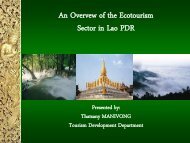GEOLOGY OF THE PENGKALAN HULU-BETONG TRANSECT ...
GEOLOGY OF THE PENGKALAN HULU-BETONG TRANSECT ...
GEOLOGY OF THE PENGKALAN HULU-BETONG TRANSECT ...
You also want an ePaper? Increase the reach of your titles
YUMPU automatically turns print PDFs into web optimized ePapers that Google loves.
60<br />
many common characteristics to share with other parts of the Bintang granite (Trgrbt).<br />
Although the exact age of the Damar granite (Trgrdm) is still remain uncertain, it is inferred<br />
to fall within the Triassic period. It is believed that the Batu Puteh/Pa Ret Tu granite<br />
(Trgrbp/pr) and Kawi granite (Trgrkw) had been formed by the magmatic differentiation of<br />
the Rimba Telui/Si Nakhon granite (Trgrrt/sn). Therefore, the emplacement of the Batu<br />
Puteh/Pa Ret Tu granite (Trgrbp/pr) and the Kawi granite (Trgrkw) probably took place<br />
during the Triassic period or younger.<br />
On the Thai side, the granites exposed in the Transect area can be correlated with the<br />
Songkhla and Satun granites. Cobbing et al. (1992) reported the age of emplacement for<br />
the Songkhla and Satun granites, which are classified in the Main Range granitoids, as<br />
Triassic period, based on radiometric age determination by Rb/Sr isochron technique.<br />
Therefore, the emplacement of granitoids in the Transect area may have been happening<br />
in the Triassic.<br />
4. STRUCTURAL <strong>GEOLOGY</strong> AND TECTONICS<br />
4.1 Introduction<br />
The structural geology of the Transect area corresponds to the regional tectonic pattern<br />
of the Peninsular Malaysia and Southern Thailand. However, detailed mapping carried<br />
out within the Transect area revealed that, in places, the local structures appear to have a<br />
slight variance as compared to the regional pattern. Peninsular Malaysia and southern<br />
Thailand were formed as a result of collisions between the Sibumasu (Shan Thai) to the<br />
west and Eastmal-Indosinia (Indochina) blocks to the east. This collision was<br />
accompanied by a major tectonic event during Late Triassic, resulting in the deformation<br />
of rocks in the region. The continent-continent collision had caused uplifting and faulting<br />
along the N-S direction. On the other hand, the formation of N-S trending fault zones had<br />
caused a widespread deposition of post-collision sediments in an approximately N-S<br />
longitudinal basin. However, the major structure of the Palaeozoic strata in this area may<br />
have been destroyed by the influence of younger Cretaceous granite intrusions and multidirection<br />
fractures were generated as a result. Finally, younger NE-SW and NW-SE<br />
fractures, which can be prominently observed in both igneous and sedimentary host rocks,<br />
may have been resulted from the movement of the major fault in the Transect area.<br />
4.2 Folding<br />
The Lower Paleozoic rocks in the Transect area are generally folded into series of<br />
broad fold structures which are characterized by steeply dipping limbs. A pattern of closeset<br />
minor folding can be seen superimposing the primary structures, especially in the less<br />
competent horizon. The NE-SW and N-S trending fold axes are sub-parallel to the long<br />
axis of the Peninsular Malaysia. On the Malaysian side, the synclinal and anticlinal axes<br />
can be recognised in the valleys of Ayer Bungur and Sungai Kuak, respectively. Other<br />
minor folds are present with small magnitude.



